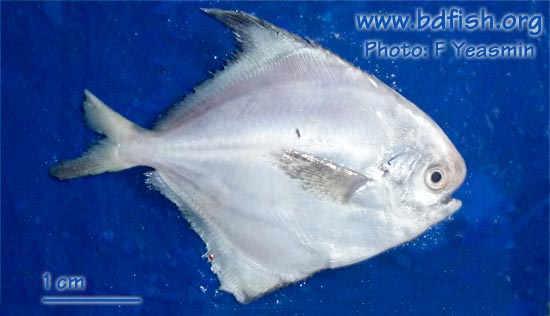
Systematic position
Phylum: Chordata
Class: Actinopterygii (Ray-finned fishes)
Order: Perciformes (Perches)
Suborder: Stromateoidei
Family: Stromateidae (Butterfishes)
Genus: Pampus
Species: P. chinensis
Synonyms
Stromateus chinensis Euphrasen, 1788
Stromateus sinensis Forster, 1795
Common/local names
English: Chinese silver pomfret and Chinese pomfret
Bangladesh: Rup chanda (রূপ চান্দা)
Distributions: India, Malay Archipelago and China (Day, 1958); Bay of Bengal, India, Hongkong except Newgini and Australia) and Japan (Shafi and Quddus, 2003)
Conservation status: Not threatened in Bangladesh (IUCN Bangladesh, 2000)
Morphology: Body compressed and somewhat oval in shape. Dorsal and abdominal profiles about equally convex. Moderately small mouth with weak jaws. Eye with narrow adipose lids. Nearly horizontal mouth and small gape present, maxilla not enlarged at below anterior margin of eye. Teeth in jaws presented in a single row and closely set fine. Body contains deciduous scales. In adult, vertical fins covered by scales. First 4-5 rays of dorsal and anal is covered by skin. Anterior portion of dorsal and anal are similar. Pelvic fin absent and caudal emarginated.
Head length 4.5-5.0 times in standard length and 3.0-3.5 in total length; Height 1.2-1.3 in standard, 1.5-2.0 in total length; Eye diameter is 4.2-4.5 ; Snout 1.5-1.7; Interorbital 2.0-2.5 (Rahman, 1989 and 2005)
With brownish dot all over the body and silvery at centre. Fins are gray with black margin.
Fin formula: D. 45-48; P1. 25-26; P2. Absent; A. 42-43 (Rahman, 1989 and 2005)
Maximum lengths: 12 cm (Rahman, 1989 and 2005), 20 cm (Munro, 2000) and 40 cm (Huda et al., 2003).
Habitats: Bay of Bengal and estuaries (Rahman, 2005); 100 m depth of muddy bottom. Sometimes found in brackish water (Shafi and Quddus, 2003); Coastal waters, trawling grounds and Palk strait (Munro, 2000); also available in estuary (IUCN Bangladesh, 200) and the Sundarbans (Huda et al., 2003).
Food and feeding: Feeds on small and soft invertebrate animal.
Fishery info: Important food fish in Bangladesh and of excellent taste; taken in both fresh and dried conditions.
__________________________________________________________
REFERENCES
Day, F. 1958. The Fishes of India: being a Natural History of the fishes known to inhabit the seas and freshwater of India., Burma and Ceylon. Reproduced in 1958 by William Dowson and Sons, London. 246 pp.
Euphrasen BA (1788) Beskrifning på 3:ne fiskar. Kongliga Vetenskaps Akademiens nya Handlingar, Stockholm 9: 51-55, Pl. 9.
Forster JR (1795) Indische Zoologie, … Zweyte sehr vermehrte Auflage (second edition). Halle. Zoologia Indica, sistens descriptiones animalium selectorum. Second Edition.: 4 unnum. pp. + i-iv + 2 + pp. 1-42 (main text) + p. 138 (Faunula Indica), Pls. I-XII + 3 unnumb. pls.
Huda MS, Haque ME, Babul AS and Shil NC (ed.) (2003) Field guide to finfishes of Sundarban, Aquatic resources division, Sundarban, Boyra, Khulna, Bangladesh, p. 175.
IUCN Bangladesh (2000) Red book of threatened fishes of Bangladesh, IUCN- The world conservation union. xii+116 pp.
Munro ISR (2000) The marine and freshwater fishes of Ceylon. Dept. of External affairs, Canberra. 224 pp.
Rahman AKA (1989) Freshwater Fishes of Bangladesh, 1st edition, Zoological Society of Bangladesh, Department of Zoology, University of Dhaka, Dhaka-1000, pp. 265-266.
Rahman AKA (2005) Freshwater Fishes of Bangladesh, 2nd edition, Zoological Society of Bangladesh, Department of Zoology, University of Dhaka, Dhaka-1000, pp. 289-291.
Shafi M and Quddus MMA (2003) Bangopshagorer Matsho Shampad (in Bengali) Kabir Publications, Dhaka, Bangladesh. p. 389.
[[[…SPECIAL THANKS…]]]
to Farjana Yeasmin, student of MS in Fisheries Biology and Genetics, Department of Fisheries, University of Rajshahi, Bangladesh for providing me the photograph, used in this article.
Visited 6,141 times, 1 visits today | Have any fisheries relevant question?
